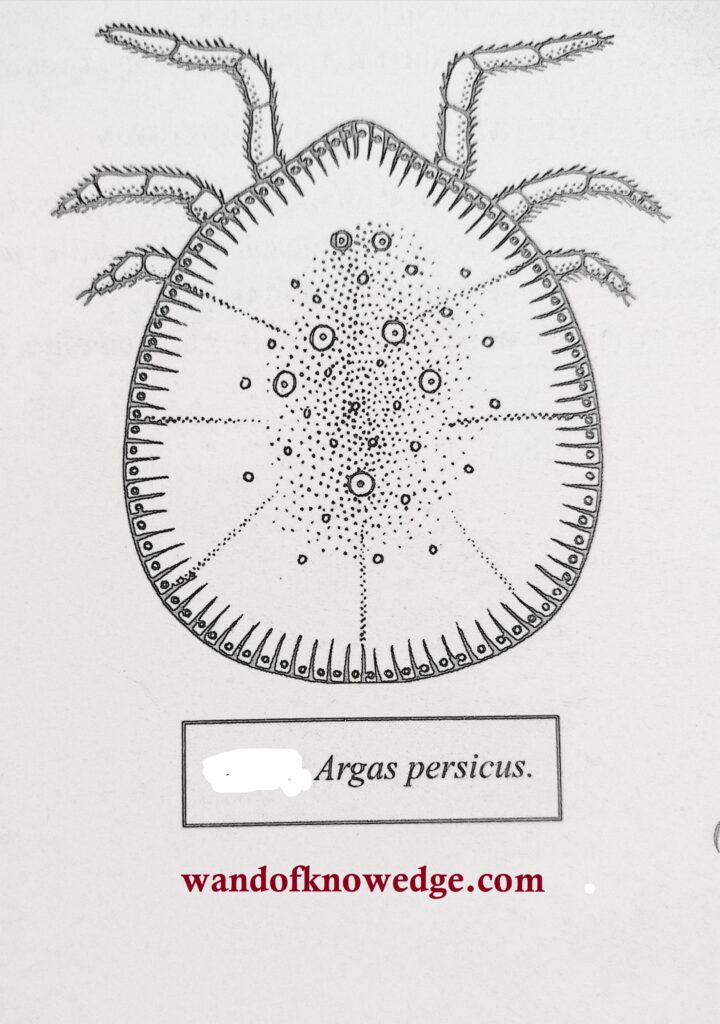Fowl Tick (Argas persicus oken) | Life History | Damage
Classification
- Phylum- Arthropoda
- Class- Arachnida
- Order- Acarina
- Family- Argasidae
- Genus- Argas

This tick is cosmopolitan in distribution and transmits spirochaetosis. Apart from fowls, the ducks and pigeons are also attacked by this tick. The feeding period for the nymphs and adults is only the night but larvae feed continuously till they are fully developed. The domestic mammals and men are rarely attacked by this tick.
Morphology
The adults are flattened, leathery and egg shaped. They are red to blue-black in colour and about 0.5 cm in length.
Life history
This tick breeds throughout the year but best breeding period is the hot dry weather. The female lays about 500 to 900 eggs in batches of 30 to 100 in cracks and crevices of fowl houses. The eggs are hatched into-6 legged larvae after 10 to 90 days of laying. The larva feeds for 3 to 10 days on fowl and attains first nymphal stage provided with 4 pairs of legs. Now nymph feeds on fowl body by sucking the blood only at night, hiding itself in cracks and crevices during the day time. Further it moults and changes into second instar nymph which again sucks the fowl blood, drops to the soil surface and after 15 days moults and changes into adult. Female can lay eggs only after taking the meal of bloods from the host. The adult can survive for about 3 years without food. The complete life cycle takes 35 to 45 days.
Damage
The poultry mites attack the skin of neck, breast, thighs, under wings and suck the blood which causes weakness of legs, pale comb, droopy wings, cessation of egg-laying and death due to severe loss of blood. A highly fatal poultry disease called as fowl spirochaetosis is causes by this tick through the transmission of Spirochaeta anserina.
Prevention and control
- The poultry houses should be sprayed by 3% malathion, 2% carbaryl on walls, floor and ceilings.
- Roosts should be suspended by wires from the ceilings so that they do not touch the walls.
- Poultry should be established only at those places where treatment of insecticides can be performed.
- The entrance of a new fowl into the flock should be with the precaution that it is tick-free. It may be treated with 0.5% chlordane before entry.
Important links
- Entamoeba histolytica : Lifecycle | Disease & Prevention
- Plasmodium: Lifecycle | Disease | Symptoms | Prevention | Treatment
- Leishmania donovani : Life cycle | Prevention and Control
- Trypanosoma gambiense: Life Cycle | Prevention and Control
- Trypanosoma cruzi: Life Cycle | Prevention and Control
- Ascaris lumbricoides : Life Cycle | Disease | Pathogenesis | Prevention
- Wuchereria bancrofti : Life Cycle | Disease | Prevention
Disclaimer: wandofknowledge.com is created only for the purpose of education and educational sector. wandofknowledge.com does not own this book/ materials, neither created nor scanned. For any queries, disclaimer is requested to kindly contact us. We assure you we will do our best. We do not support piracy. If in any way it violates the law or there is any problem, please mail us on wandofknowledge539@gmail.com
